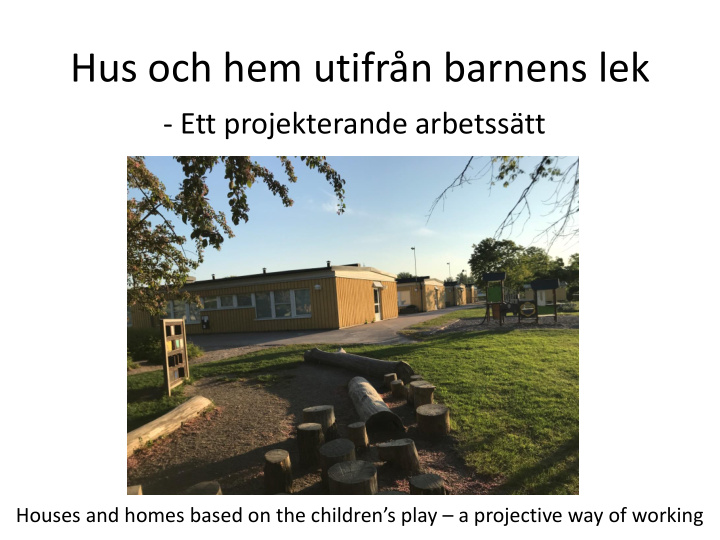



Hus och hem utifrån barnens lek - Ett projekterande arbetssätt Houses and homes based on the children’s play – a projective way of working
Uppstarten How it all began We observed that the children enjoyed constructing buildings and started moving in to them. The houses became homes.
Kartonghuset The cardboard house We added material to the pre-school environment, a large cardboard box. This became a house and the children began discussing rooms, furniture and even floorplans.
The cardboard house moved out to our yard and got reinforced. It also got a coat of paint. After a while the house was all broken because the children enjoyed playing with it so much.
Skapande av olika hus Creating different houses After changes in the seasons the children picked up an interest for bugs and started discussing where the bugs lived. They gathered wood and started building houses for the insects.
Hur vi organiserar oss How we organize ourselves
Miljö och material Enviroment and material • Hur utvecklar vi vår miljö i projektet? – How do we develop the environment in the project? • Vilken miljö erbjuder vi barnen? – What type of enviroment do we offer the children? • Hur använder barnen miljön? – How do the children use the environment?
Organisation av tid och människor Organisation of time and resurses • Hur organiserar vi oss pedagoger? – How do we organize the staff? • Hur organiserar vi barnen? – How do we organize the children? • När arbetar vi med projektet? – When do we work with the project? LEAN inspirerad whiteboardtavla
Kommunikation och förhållningssätt Communication and approach • När? Hur? Var? Varför? – When? How? Where? Why? • Hur arbetar vi med projektet? Keynote – How do we work with the project? • Hur samarbetar vi med föräldrarna i projektet? – How do the childrens parents get involved in the project?
Förskolans läroplan The pre-school curriculum • Hur uppfyller vi kraven som ställs i läroplanen? – How do we reach the goals in the curriculum? • Varför arbetar vi projekterande? – Why do we work with project planning? Läroplan för förskolan Lpfö 98, reviderar 2016 The Swedish pre-school curriculum
Bee-hives Discuss • What does your pre- school enviroment say to the childen? • How important is the thoughts behind the enviroment/roomplaning?
Vart bor vi? Where do we live? Do the pre-school teachers live at the kindergarten? Or do they have homes as we do? We visit the children’s houses in the neighborhood and with help of Google Maps.
Projicering Projections Here are a few examples of how we have used projections of the childrens houses and different types of houses.
Husen på golvet s The houses on the floor Educational documentation. We put pictues of all the children’s houses on the floor to make them avalible for the children at all times. The children started lying on the floor and reflected on the differences between their houses.
De två husen The two houses A memorable moment is how a parent e-mails pictures of their house and we get two pictures. One at the house in their home country and one at their house in Sweden. The father usually drops his son of right inside of the door very quickly. One day he sees the documentation of their two houses on the floor and starts participating in a whole different way than before. He takes an interest in his son's time at the preschool through the project. He’s sitting on the floor talking about the pictures with the boy and myself (in the staff) and discusses the different homes and shows interest in how we work.
Pedagogisk dokumentation Educational documentation When the children observed the pictures of their houses, they noticed that two of the houses had different colors on the doors. One was blue and the other one green. This was subject for some lively discussions. We introduced the book "Knock Knock Knock ”.
Knacka på Knock Knock Knock A book called Knock, knock, knock was introduced to the childern and was projected to the walls. This is a movie of the children exploring the book.
Magnatiles The children also enjoyed playing with a material called magnatiles. They built houses, talked about who lived in the houses and visited each others houses.
Blue- bot Kartan över barnens hus. The map over the childrens houses.
Roboten och Babblarna The robot and Babblarna We extended the project with a Blue-Bot after noticing their facination for robots. We combined the childrens interests for robots with their interesets for Babblarna (a Swedish pedagogical language material) and the homes of Babblarna. In to the project now came the Blue-bot. It made visits to the homes of the different characters of Babblarna.
The children are listening to a book of Babblarna called ”Dadda visits”. After the book I continue the storyline to introcude the robot and how to program it to visit its friend Dadda’s house.
This is how it can look after the children have discussed a path home to Dadda and programmed the robot.
Vi tecknar våra hus W e’re drawing our houses
Puppet pals Diskutera * Använder ni teknologi i era förskolor? * På vilket sätt? * Hur berikar det barnens lek? We’re using an app called Puppet Pals that lets the children create movies. They choose a background picture and we use a picture of the child as a puppet.
Tack för oss! Om ni har några funderingar får ni gärna höra av er till oss. Thank you! If you have any questions, feel free to contact us. Monica Cervin Lindefalk, förskollärare Nordanby förskola monica.cervin.lindefalk@vasteras.se Eva Svanbäck-Lidman, förskollärare Nordanby förskola eva.svanback.lidman@vasteras.se
Recommend
More recommend